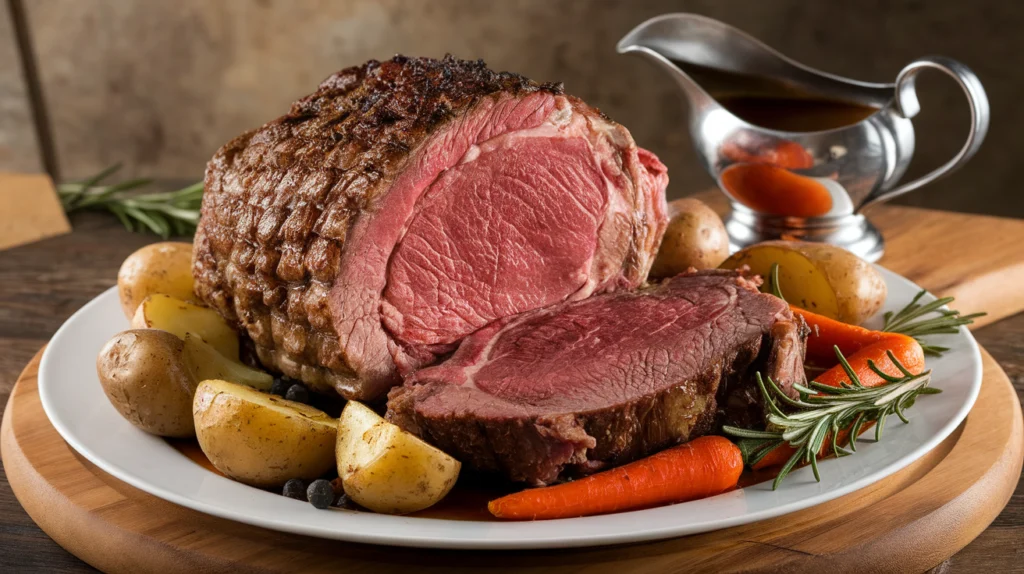There’s something magical about the holidays, isn’t there? The gathering of loved ones, the joy of sharing stories, and the sheer delight of savoring a meal together. If you’re planning a Christmas dinner or a cozy family feast, you want a centerpiece dish that feels special but isn’t overwhelming to prepare. Enter the small prime rib roast—a cut of beef so rich in flavor and tenderness that it practically guarantees rave reviews from everyone at the table.
This guide walks you through how to cook a small prime rib roast to perfection. Whether you’re an experienced home chef or trying this dish for the first time, you’ll find clear steps, tips, and insights that make this recipe not only doable but utterly delightful. Let’s get started!
Table of Contents
What is a Prime Rib Roast? (Understanding Your Star Ingredient)
Before you dive into seasoning and roasting, let’s take a moment to understand what makes the prime rib roast so unique.
Key Characteristics of Prime Rib
Prime rib, often referred to as a standing rib roast, comes from the primal rib section of the cow. This cut is prized for its exceptional marbling, which melts into the meat as it cooks, delivering mouthwatering juiciness and flavor. Unlike a ribeye steak, which is cut from the same section but served individually, a prime rib roast is cooked as a whole piece, making it ideal for feeding a small group.
Why It’s Perfect for Small Gatherings
A small prime rib roast (usually 3–5 pounds) is the perfect size for intimate occasions, feeding about 4–6 people. It offers all the indulgence of a larger roast without the stress of managing leftovers or overcrowding your oven.
How to Choose the Best Prime Rib Roast
Not all prime rib roasts are created equal. Selecting the right one is key to achieving a restaurant-quality result at home.
What to Ask Your Butcher
- Grade Matters: Look for USDA Prime or USDA Choice. Prime-grade beef has the highest marbling but can be pricier. Choice is more budget-friendly and still delicious.
- Bone-In or Boneless: Bone-in roasts often have more flavor and serve as their own natural roasting rack. Boneless is easier to carve but may cook slightly faster.
Sizing Guide for Small Prime Rib Roasts
Use the rule of one pound per person when determining the size of your roast. For example:
- 3 pounds: Serves 3–4 people.
- 4 pounds: Serves 4–5 people.
- 5 pounds: Serves 5–6 people.
Tools and Ingredients You’ll Need
Before you begin, gather everything you need for a seamless cooking experience.
Kitchen Tools
- Roasting pan with a rack.
- Meat thermometer (instant-read or digital).
- Sharp carving knife.
- Aluminum foil for resting.
Ingredient Table
| Ingredient | Quantity |
| Small prime rib roast | 3–5 pounds |
| Kosher salt | 2–3 tablespoons |
| Fresh black pepper | 1–2 tablespoons |
| Garlic cloves | 4–6, minced |
| Olive oil or butter | 2–3 tablespoons |
| Fresh rosemary | 2–3 sprigs |
| Fresh thyme | 2–3 sprigs |
How to Cook a Small Prime Rib Roast
Cooking a small prime rib roast might sound intimidating, but it’s actually quite straightforward. Follow these steps to achieve tender, juicy, and flavorful results every time.
Step 1 – Preparing Your Prime Rib Roast
- Bring it to Room Temperature: Remove your roast from the fridge about 2 hours before cooking. This ensures even cooking.
- Season Generously: Pat the roast dry with paper towels, then rub it all over with kosher salt, freshly cracked black pepper, minced garlic, and olive oil or melted butter. For extra flavor, press rosemary and thyme sprigs onto the surface.
Step 2 – Preheating and Setting Up
- Preheat your oven to 450°F. This high temperature helps sear the exterior, creating a crust that locks in the juices.
- Place the roast on a rack in a roasting pan to allow heat to circulate evenly around the meat.
Step 3 – Cooking Instructions
- Searing: Roast at 450°F for 20 minutes. This step develops a rich, golden crust.
- Lower the Temperature: Reduce the oven to 325°F and continue cooking until the internal temperature reaches 120°F for rare, 130°F for medium-rare, or your desired doneness. To ensure perfect doneness, use a meat thermometer to measure the internal temperature at the thickest part of the roast.
Step 4 – Resting and Carving
- Rest the Meat: Once it’s done, remove the roast from the oven, tent it loosely with foil, and let it rest for 15–20 minutes. Resting the roast after cooking allows the juices to settle evenly, making each bite tender and flavorful.
- Carve Against the Grain: Use a sharp carving knife to slice the roast into portions, cutting against the grain for maximum tenderness.

Doneness Guide (Use a Meat Thermometer)
| Doneness | Temperature (°F) |
| Rare | 120–125 |
| Medium-Rare | 130–135 |
| Medium | 140–145 |
| Medium-Well | 150–155 |
Tips for the Perfect Prime Rib Roast Every Time
Cooking a prime rib roast is an art, and these pro tips will ensure you achieve perfection.
- Patience is Key: Let the roast rest at room temperature before cooking and after roasting to lock in moisture.
- Invest in a Thermometer: Precision matters, and guessing the doneness can lead to disappointment.
- Season Early: Season your roast the night before for deeper flavor penetration.
Side Dishes to Complement Your Prime Rib Roast
A prime rib roast deserves equally delicious accompaniments. Here are some classic options:
- Creamy Mashed Potatoes: The buttery, velvety texture pairs perfectly with the robust flavors of the roast.
- Roasted Vegetables: Try carrots, parsnips, or brussels sprouts tossed with olive oil and herbs.
- Yorkshire Pudding: These fluffy, golden popovers soak up all the delicious juices from the roast.
- Fresh Dinner Rolls: Soft, warm rolls are a must for sopping up gravy.
FAQs About Cooking Prime Rib Roast
What’s the recommended cooking time for a small prime rib roast?
The general rule is 15 minutes per pound at 325°F after the initial sear. That said, it’s best to depend on a meat thermometer for precise results.
What’s the difference between a prime rib roast and a ribeye steak?
Prime rib is a larger cut from the rib section, cooked as a roast. Ribeye is the same meat but cut into individual steaks.
Can I prepare prime rib ahead of time?
Yes! Season your roast the night before and refrigerate it uncovered. This dry brining enhances flavor and promotes a crispy crust.
Conclusion
Cooking a small prime rib roast is simpler than you might think, and the results are nothing short of spectacular. Whether it’s the star of your Christmas dinner or a memorable family gathering, this dish delivers on flavor, tenderness, and that wow factor you’re looking for.
Ready to create your own masterpiece? Follow this guide step by step, and you’ll soon have a roast that brings smiles to every face around your table. Don’t wait—try it out and experience the joy of serving a meal that’s as heartfelt as it is delicious.
Nutritional Information
| Serving | Calories | Protein (g) | Fat (g) | Carbs (g) |
| 6 oz. slice | 500 | 36 | 40 | 0 |
Cooking is all about sharing love, and there’s no better way to show you care than with a perfectly cooked prime rib roast. Now it’s your turn to make memories with this timeless recipe. Let the roasting begin!


1 thought on “How to Cook Prime Rib Roast Step-by-Step To Perfection”